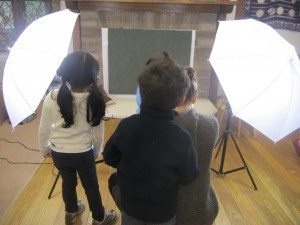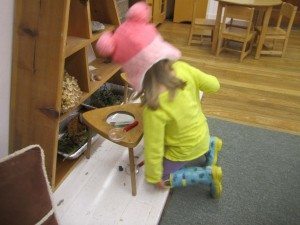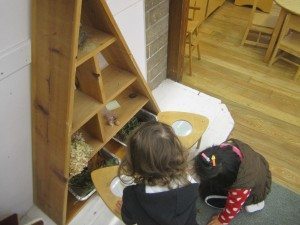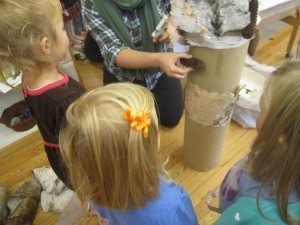While grown-ups recognize that pretending helps children find their way into the world, many adults think of play as separate from formal learning. The reality is quite different. As they play, children develop vital cognitive, linguistic, social and emotional skills. They make discoveries, build knowledge, experiment with literacy and math and learn to self-regulate and interact with others in socially appropriate ways. Play is also fun and interesting, which makes school a place where children look forward to spending their time. It is so deeply formative for children that it must be at the core of our early childhood curriculum.
What does purposeful play look like? When you step into an exemplary pre-K classroom, you see a room organized by a caring, responsive teacher who understands child development. Activity centers are stocked with materials that invite exploration, fire the imagination, require initiative and prompt collaboration. The room hums.
New York Times, What a Preschool Should Look Like Op-Ed article by Bank Street College president Shael Polakow-Suransky and Professor Nancy Nager
We encourage you to read this full article from The New York Times. It affirms what we believe and do at BCD – purposeful play, exploration and discovery, creative, transformative thinking, initiative, and collaboration.
Our activity centers this week promoted all these things:
- Color exploration – We painted using the water colors we made last week. We experimented with water and primary colors of food dye to create new colors. This inspired a lot of discussion and “what if’s.” We also had a discussion about the wonderful black and white photos of everyone that Ms. Sicurella took and why they are not in color. Ms. Sicurella also laminated color prints of the same photos, which led to interesting comparisons, connections and a memory game.
- Painting – Our easels and paints center promotes exploration of color, line and composition, fine motor development and expressive communication.
- Magnifying nature – We presented a center with different sized magnifying glasses and samples from our nature walks such acorns and other nuts, a fossil and pine cones. Your children loved seeing these familiar objects from a different perspective!
- Dominoes – We put dominoes out to follow up on the dot project that Heather introduced this week (see below).
- Our tree – This project over time to make our own tree was initiated by the children. We decided that to our cardboard tube we would only add things that a tree would have. This collaborative activity is very popular, as the children think about what they want to add and work with others to create it. They also make a lot of observations. For example, CJ said he learned something new, that a small pinecone can balance on the bigger one that is glued. We introduced fabric, too, and children drew or traced leaves on them and then used permanent markers to add veins. Nicolette observed that it looks like a real tree! This has given added purpose to our nature walks, too, and this week we found lots of big BIG leaves that we gathered and brought back for our tree. We also wondered why there are brown leaves on the ground but colorful ones in the trees. We wondered why water stands in dots (droplets) on leaves and where the bugs went. Isabel said that they are hibernating and Aidan explained that means when you rest and you go to sleep.
- Writing table – We have paper and pencils on a table near our word wall that our 4’s use to make books. Sometimes they write and sometimes they dictate what they want written in their books. If they want to know how to write a word, we write it and put it on their word wall.
Topics depend on their interests and include everything from super powers to kitties!
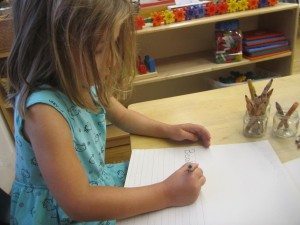

- Important other centers that we will talk about in future blogs are Weaving, Dress up, Housekeeping, Dollhouse and Building (blocks, legos, marble runs, and the like.)
Circle time – Often we do not have a specific instruction block as our learning happens naturally in the rhythm of our daily activities. Every aspect of our circle time involves some kind of instruction. We integrate all aspects of social and cognitive development using music, French, math, language arts, social studies and science. After our greeting we read the morning message, we sing the days of the week song and say what day of the week it is. We say the date and we count the days we have been in school. We write and/or place the number on the wall. The numbers of the October calendar days alternate with yellow and orange so we figure out what color comes next in the pattern, too. We have also begun bundling the numbers of the days with straws. On Friday, for example, we had been in school for 36 days, which meant 3 bundles of 10 straws each plus 6 singles. We always say what the weather is, too.
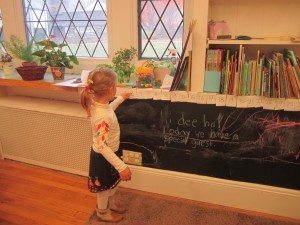
We often take out our counting stones or our counting bears to count 1-10 and to practice one on one counting. Our 4’s are counting to 20. We also use circle time to practice letter formation basics using the Handwriting Without Tears method of big line/little line, big curve/little curve (which all letters have). This week everyone had a chance to make letters on the chalkboard and we all wrote letters in the air, too.
Books – We read books throughout the day, especially at transition times such as after recess or before rest. Our stories continue to reinforce social, emotional and cognitive skills and concepts. We read a rhyming, repetition book about ants, a “feelings” book by Mo Williams, sequencing stories by Richard Scary, a preposition book, and a colors story by Eric Carle. Isabel’s mom Heather read a counting, rhyming story about 10 little dots and the children discussed what the configurations of dots made. They extended the story by gluing black dots on paper and then making a drawing from it.
Sonya noticed that the dots on the dice look like people. CJ said that there are different numbers on the dots. Neha noticed the words on the pages. Noelle noticed 10 little dots. Nicolette said they looked like lollipops. Angeliz made a train and Isabelle said that the dot is a lightbulb (in the classroom.)
Art with Ms. Sicurella – Ms. Sicurella continued to work on a collaborative piece. The children are creating a design on a big piece of wood using various media – cray pas, different pieces of wood, tissue paper, and things with other textures and dimensions.
French – At snack one day this week your children spontaneously began to have conversations in French! What fun they had saying “Bonjour” and “Je m’appelle…” to one another! We had a big treat this week when Madame, the French teacher, came to our classroom to sub and did a full lesson of stories and activities with them. She was very impressed with their French and with their enthusiasm!
9th Grade Buddies – How nice it was to have Ruby, Michelle and Evan, our wonderful 9th grade buddies, back from their trip to Europe! They are terrific with your children. They are able to diffuse tension with humor, use diversion strategies when necessary, and be creative with their engaging conversations and activities. They love being with our class! As a special treat on Friday afternoon, they brought us a huge pumpkin carved with a nature theme (a tree!) complete with (fake) candles. We will miss them as they work in their classroom for the next two weeks but look forward to their return!
Some reminders:
Please dress your children appropriately for the weather.
We encourage you to send in processed-free and sugar-free snacks and lunches.
For those of you viewing this blog on your iphone or ipad, you can view the pictures here: https://www.flickr.com/photos/bcdtech/sets/72157647254977052/
